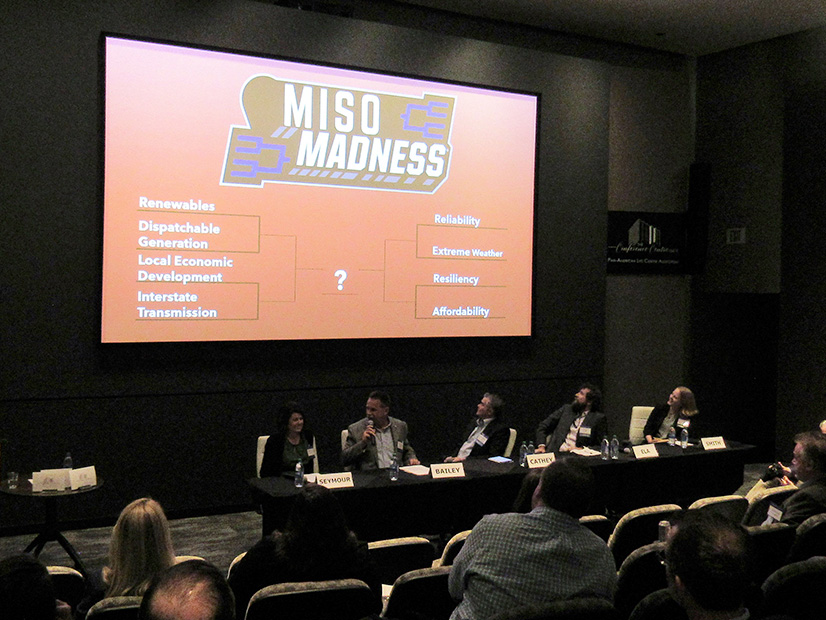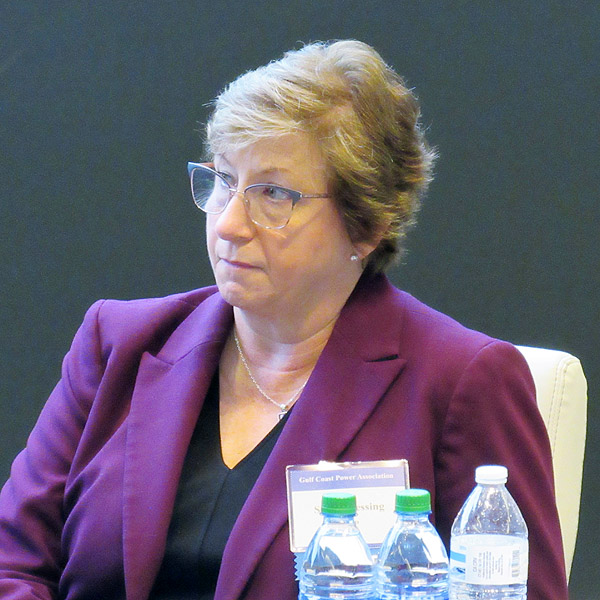
NEW ORLEANS — MISO and SPP members’ continued addition of renewable resources and more socially responsible operations is gaining speed, industry experts said at Gulf Coast Power Association’s MISO-SPP conference.
Mississippi Public Service Commissioner Brent Bailey opened one panel with a “MISO Madness” bracket that pitted together concept renewables and dispatchable generation, reliability and extreme weather, and resilience and affordability. Bailey said the chart, which included a large question mark in the winner’s spot, shouldn’t be interpreted as an either/or scenario.
 Mississippi Public Service Commissioner Brent Bailey’s MISO Madness bracket | © RTO Insider LLC
Mississippi Public Service Commissioner Brent Bailey’s MISO Madness bracket | © RTO Insider LLC
“You can fill out your own bracket up to 64 [terms],” he said.
Electric Power Research Institute’s Erik Ela said a decarbonized grid should be focused on resource adequacy, flexibility and price formation.
“I hear often, ‘Products, products, products.’ If there’s an issue, create a new product,” he said, saying new technologies, not just market products, could ease the renewables takeover. Ela said wholesale markets must consider pricing when resources don’t have fuel costs, but do have marginal costs from battery storage, long-duration energy storage and more dynamic demand response.
 Casey Cathey, SPP | © RTO Insider LLC
Casey Cathey, SPP | © RTO Insider LLC
Casey Cathey, SPP’s director of system planning, said that for the past couple of years, zero-marginal cost resources account for 10% of the RTO’s systemwide marginal energy pricing component.
“The markets were never designed for this,” he said.
Casey said even with 31 GW of installed wind capacity, there are still times when SPP’s wind generation fleet has a 1% capacity factor. Before the conference, the grid operator set renewable penetration records March 28 and 29, where renewable energy served more than 90% of the demand for electricity across its 14-state footprint.
“When we’re hitting these records it’s almost a blessing … kind of a curse,” Casey said, noting the record-breaking intervals give SPP insights into resource-adequacy requirements, improved outage planning and transmission needs.
SunChase Power Vice President Teran Smith said the industry is “finally” arriving at an era of mass solar buildout after delays because of low-cost natural gas and a breakneck wind buildout. She said there’s currently a “mismatch” between demand and supply caused by sluggish interconnection queues and expensive network upgrade costs tagged onto solar projects.
Multiple panelists agreed transmission projects on the horizon will deliver renewable generation.
Bailey said Mississippi will steadfastly advocate a “beneficiary pays” cost allocation for transmission projects. “We do quite often beat the drum around costs,” he said.
ESG Becomes the Norm
Another panel discussed the rising impact of environmental, social and corporate governance (ESG) and the electric sector’s emphasis on sustainability.
“The electric power is at the forefront of ESG,” Kean Miller partner Gordon Polozola said. “It’s not just an acronym anymore.”
 AEP’s Sandy Nessing | © RTO Insider LLC
AEP’s Sandy Nessing | © RTO Insider LLC
“We’re on the cusp of a major generational shift, not just in our industry but across the board,” said Sandy Nessing, American Electric Power’s new managing director for corporate sustainability. “The next generation looks at ESG and sustainability as a must-have. … It’s under increasing scrutiny.”
Nessing said AEP never fielded questions about diversity, equity and inclusion prior to 2020. She said ESG and sustainability is headed from “voluntary to mandatory,” citing the Securities and Exchange Commission’s recent approval of a measure requiring climate-related disclosures. She said that rule “sets the stage” for what’s to come.
Shareholder ESG proposals jumped 22% last year, Nessing said. Many focused on reducing greenhouse gas emissions and transitioning to clean energy. Nessing said investors are increasingly asking utilities to lay out their transition plans from 2030 to 2050.
Activism is increasing and not coming from just shareholders, Nessing added. She said activist organizations will sometimes invest to get a seat at the table and force change.


